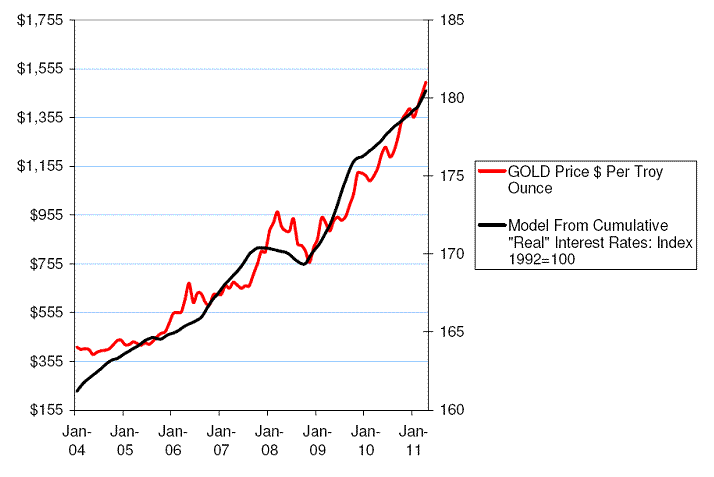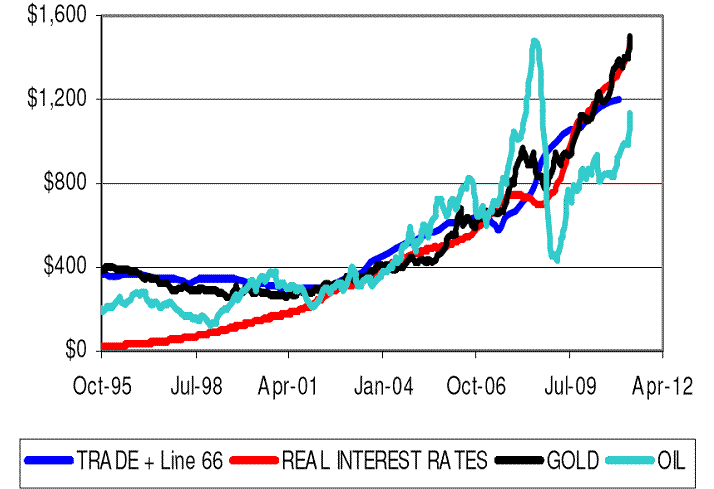Real Interest Rates Explain the Gold Price Perfectly…Too Perfectly?
Commodities / Gold and Silver 2011 Apr 25, 2011 - 03:11 AM GMTBy: Andrew_Butter
 The latest idea coming out of the “Hedge-Fund” camp that I saw to explain the recent meteoric climb in the price of gold as expressed in US dollars is “Real” interest rates.
The latest idea coming out of the “Hedge-Fund” camp that I saw to explain the recent meteoric climb in the price of gold as expressed in US dollars is “Real” interest rates.
Leaving aside what is “real” and what is illusion for a moment, if you take a timeline of the US 10-Year Treasury yield and subtract the published CPI number you get to one (of many) estimates of “real” interest rates. Then you cumulate that number, you can build a reasonably decent “explanatory” model to explain the price of gold, since say January 2002.

Month on month the correlation between those two lines is 95% , so you can say that the changes in the “real” interest rates since January 2004 can “explain” 95% of the changes in the price of gold.
And the logic there is I suppose that the price of gold “ought” to give you a “real” return on your money, although over the past seven years gold went up nearly five times but the “real” return on a 10-Year Treasury was about 13%.
If you buy that logic then to know where the price of gold is going, all you need to do is guess where American CPI and where the 10-Year Treasury yield is going. There again, there are plenty of other explanations for the current price of gold. Here are three good ones:
1: The Austrians:
The “Austrians” say that “fiat money-printing” by central bankers debased and destroyed the value of money in general, so the value of “real” money (gold) went up. That’s a logical argument; certainly the explosion of the price of gold tracks (sort of) the explosion of the US Federal Reserve balance sheet over the past few years.
Although it’s quite hard to fit facts to the reality, gold started going up before the Fed started expanding its balance sheet, and in any case the connection between the balance sheet and “money printing” is tenuous.
That’s because the Fed is supposed to lodge collateral (US Treasuries or MBS for example) with the Federal Reserve Agent (a government employee), prior to printing money. So the idea of “Helicopter Ben” just irresponsibly turning on the printing presses whenever he feels like it; is a bit of an old-wives-tale. Of course you can debate what value the Federal Reserve Agent accepted for the $1.5 trillion of MBS that the Fed put up as collateral, but most of that money just turned straight round to be put on deposit with the Fed so the affected banks could bolster their capital adequacy.
Thus the logic in the Austrian camp tends to be weighted towards philosophical arguments (often quite long-winded), which may be right, but they are as hard to pin-down. The problem I have with all that is the idea that central bankers and those who sail with them were FIVE times more venal and/or incompetent, over the past seven years than they were in the past twenty years (when gold was much cheaper).
2: Oil and Gold:
There is a pretty good correlation between the price of oil and the price of gold since 1971 when gold was “liberated” from the grasp of central bankers (74% R-Squared).
There is an attractive logic there in the sense that gold has a fundamental irreplaceable value in society and so does oil. The problem with that logic is that at $125 oil the “fundamental” price of gold should be $1,100 or so, so either (a) there is a bubble or (b) the valuation model does not stack up, or (c) oil is on it’s way up to $175 a barrel and gold is simply front-running that inevitability.
The issue on that count is at what point the “fundamental” price of oil will migrate from what it is as dictated by “Parasite Economics” (how much the world can pay without it’s economy being damaged – currently about $90), into the “replacement cost” which is how much it will cost to find new supplies, which potentially can go up exponentially if the “Peak Oil” argument holds water.
3: “Effective Current Account Deficit”
The idea there is that (a) the fundamental value of the dollar (i.e. against something with “fundamental value” ought to be reflected in the cumulative US trade deficit (goods + services) (b) except since 2000 you have to treat any “US Securities Other Than US Treasuries” (line 66 of the BEA International Transactions – sometimes called “Toxic Assets”), as “exports”, as in the loans won’t get serviced so the net result is that USA “exported” the title to a proportion of their homes.
Add that up and you get a line that tracks the price of gold pretty accurately since 1993, in fact it explains the changes in the price of gold expressed in dollars much better than either the price of oil (well oil had a bubble and a bust), or “real” interest rates.
I admit that’s a pretty whacky line of logic, but it does at least provide a measure of the cost to America of living beyond its means, in comparison to the reality of its economy compared to that of the rest of the world. Only by that logic the “correct” price of gold is $1,200 today.
Comparing the three approaches

Discussion:
1: The problem with “real” interest rates as an explanatory variable is that it only started to “work” in about 2004. One thought that comes to my mind is that perhaps the clever hedge fund herd is tracking that variable these days…and perhaps they have the wrong end of the stick? That wouldn’t be the first time the too-clever-by-half hedge-fund boys got it wrong.
2: Oil is a big part of why America runs a trade deficit, but it’s not the only thing.
3: The best correlation is the trade deficit, which at least does not require a long-convoluted argument to explain away; if (a) gold is a substance that accurately measures value long-term in the world as a whole, and (b) America is living beyond its means reference the whole world (and in that regard the trillions it spends “defending” itself sound more and more like narcissism as time passes), then ultimately, what America will be able to afford to buy from the rest of the world, will go down, thus the dollar compared to “value” in the rest of the world will go down.
That story-line suggests there may have been some “over-cooking” over the past six months, only time will tell.
By Andrew Butter
Twenty years doing market analysis and valuations for investors in the Middle East, USA, and Europe; currently writing a book about BubbleOmics. Andrew Butter is managing partner of ABMC, an investment advisory firm, based in Dubai ( hbutter@eim.ae ), that he setup in 1999, and is has been involved advising on large scale real estate investments, mainly in Dubai.
© 2011 Copyright Andrew Butter- All Rights Reserved
Disclaimer: The above is a matter of opinion provided for general information purposes only and is not intended as investment advice. Information and analysis above are derived from sources and utilising methods believed to be reliable, but we cannot accept responsibility for any losses you may incur as a result of this analysis. Individuals should consult with their personal financial advisors.
Andrew Butter Archive |
© 2005-2022 http://www.MarketOracle.co.uk - The Market Oracle is a FREE Daily Financial Markets Analysis & Forecasting online publication.



